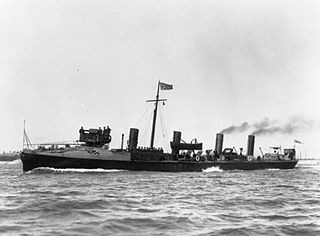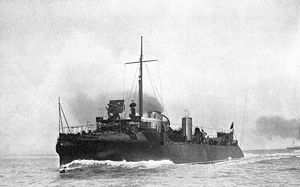
In naval terminology, a destroyer is a fast, maneuverable, long-endurance warship intended to escort larger vessels in a fleet, convoy, or carrier battle group and defend them against a wide range of general threats. They were originally conceived in 1885 by Fernando Villaamil for the Spanish Navy as a defense against torpedo boats, and by the time of the Russo-Japanese War in 1904, these "torpedo boat destroyers" (TBDs) were "large, swift, and powerfully armed torpedo boats designed to destroy other torpedo boats". Although the term "destroyer" had been used interchangeably with "TBD" and "torpedo boat destroyer" by navies since 1892, the term "torpedo boat destroyer" had been generally shortened to simply "destroyer" by nearly all navies by the First World War.

A torpedo boat is a relatively small and fast naval ship designed to carry torpedoes into battle. The first designs were steam-powered craft dedicated to ramming enemy ships with explosive spar torpedoes. Later evolutions launched variants of self-propelled Whitehead torpedoes.

The Havock class was a class of torpedo boat destroyer (TBD) of the British Royal Navy. The two ships, Havock and Hornet, built in London in 1893 by Yarrow & Company, were the first TBDs to be completed for the Royal Navy, although the equivalent pair from J.I. Thornycroft, Daring and Decoy, were ordered five days earlier.

HMS Havock was a Havock-class torpedo boat destroyer of the British Royal Navy built by the Yarrow shipyard. She was one of the first destroyers ordered by the Royal Navy, and the first to be delivered.

The A class as designated in 1913 was a heterogeneous group of torpedo boat destroyers (TBDs) built for the Royal Navy in the mid-1890s. Some 42 vessels were constructed to the individual designs of their builders to meet Admiralty specifications, the only uniting feature being a specified top speed of 27 knots (50 km/h). In fact the initial six vessels were generally differentiated by a slightly lower speed and were often referred to as "26-knotters" to distinguish them from the following batch of thirty-six vessels; all fifteen surviving "27-knotter" vessels were classified by the Admiralty as the A class in 1913 to provide some system to the naming of HM destroyers. All of the "26-knotters" and most of the "27-knotters" had been lost or scrapped before the 1913 classification, but for convenience all 42 ships are listed below. The number of funnels varied from one to four. All vessels had a distinctive "turtleback" forecastle that was intended to clear water from the bow, but actually tended to dig the bow in to anything of a sea, resulting in a very wet conning position.

The D class as they were known from 1913 was a fairly homogeneous group of torpedo boat destroyers (TBDs) built for the Royal Navy in the mid-1890s. They were all constructed to the individual designs of their builder, John I. Thornycroft & Company of Chiswick, to meet Admiralty specifications. The uniting feature of the class was a top speed of 30 knots and they all had two funnels.

HMS Hornet was a Havock-class torpedo boat destroyer of the British Royal Navy. She was launched in 1893 and sold in 1909 for scrapping. Although the Daring-class torpedo boat destroyers were ordered first, Havock and Hornet were completed faster, making them the first destroyers ever built.

HMS Daring and HMS Decoy together made up the Daring class of torpedo boat destroyers which served with the Royal Navy during the turn of the 19th and 20th centuries. On trial she made headlines as the 'Fastest Boat Ever'. The introduction of steam turbines after 1897 quickly made her and her sisters obsolete and she was sold off in 1912.

Two Ferret-class destroyers served with the Royal Navy. Ferret and Lynx were built by Laird, displaced 280 tons and were 199 feet (61 m) in overall length.

The three Ardent-class torpedo boat destroyers were ordered by the British Admiralty on 12 October 1893 and served with the Royal Navy. Built by Thornycroft for a contract price of £110,520 for all three vessels, they displaced 301 tons fully laden, and were 201 feet 8 inches (61.47 m) long overall.

HMS Ardent was a Royal Navy 27 knot torpedo boat destroyer ordered from John I Thornycroft & Company under the 1893 – 1894 Naval Estimates. She was the sixth ship to carry this name.
HMS Boxer was an Ardent-class destroyer which served with the Royal Navy, launched on 28 November 1894. She spent several years operating with the Mediterranean Fleet and remained active during the First World War. She was sunk in a collision on 8 February 1918.

HMS Bruizer was an Ardent-class destroyer which served with the Royal Navy. She was launched on 27 February 1895 by John Thornycroft at Chiswick, and was sold on 26 May 1914.

The three Charger-class destroyers were all ordered by the British Admiralty on 12 October 1893 and on completion in early 1896 they served with the Royal Navy until 1911.
HMS Hasty was a Charger-class destroyer which served with the Royal Navy. She was launched by Yarrow Shipbuilders in 1894, served in home waters and was sold off in 1912.

The Banshee class was a class of three torpedo boat destroyers that served with the Royal Navy into the early part of the Twentieth century.
Two Swordfish-class destroyers served with the Royal Navy. Swordfish and Spitfire were both built by Armstrong Whitworth at Elswick, Tyne and Wear launching in 1895. Fitted with Yarrow boilers, they could make 27 knots and were armed with one twelve pounder and two torpedo tubes.

HMS Fame was a two funnel, 30 knot destroyer of the Royal Navy, ordered under the 1894–1895 Naval Estimates. She was launched in 1896, served in Chinese waters for the whole of her life and was sold at Hong Kong in 1921.

HMS Sunfish was a "twenty-seven knotter" torpedo boat destroyer of the British Royal Navy. Built by the Tyneside shipbuilder Hawthorn Leslie, Sunfish was one of three destroyers built by Hawthorns that year. She was sold for scrap in 1920.












